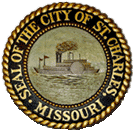|
St. Charles |

Seal of St. Charles
|
 Seal of St. Charles |
|
St. Charles Founded by French Canadians in 1769, St. Charles was called Les Petites Cotes—“the little hills”—for the low bluffs along the Missouri River that form the town's backdrop. Under the Spanish government many American settlers came into the District of San Carlos, which extended west from the Missouri River to the Pacific Ocean. Among those who flocked to the territory during the 1790s were Daniel Boone and his family. In 1804 Upper Louisiana was formally transferred from France to the United States, and San Carlos became St. Charles. Lewis and Clark embarked on the Missouri River from St. Charles in 1804 to explore the Northwest Territory. When Missouri was admitted to the Union on Aug. 10, 1821, St. Charles became the first capital of the state. Although the capital was moved to Jefferson City in 1826, the city continued to grow. St. Charles was an early center for education west of the Mississippi; the Academy of the Sacred Heart was established in 1818 by Rose Philippine Duchesne, who was canonized in 1988. Lewis and Clark Heritage Days in mid-May commemorate the arrival in St. Charles of William Clark and the Corps of Discovery, where the explorer met up with Meriwether Lewis. A large encampment along the Missouri River is the site for demonstrations of frontier skills, period craft displays and a rousing Fife and Drum Corps muster. In mid-August nearly 300,000 people help St. Charles celebrate Fete des Petites Cotes—Festival of the Little Hills. A 19th-century atmosphere prevails at this summertime event, which offers craft demonstrations, food and entertainment. The population of St. Charles in 1900 was 24,474. In the 2000 Census the population of St. Charles was 61,253 making it the 9th largest city in Missouri. The City of St. Charles is headquarters for Quilogy, Growing Family, RX System, NewCo Enterprises, Client Services; and home to the regional offices of Coca Cola Enterprises, Sysco and American Freightways. |
Links: |